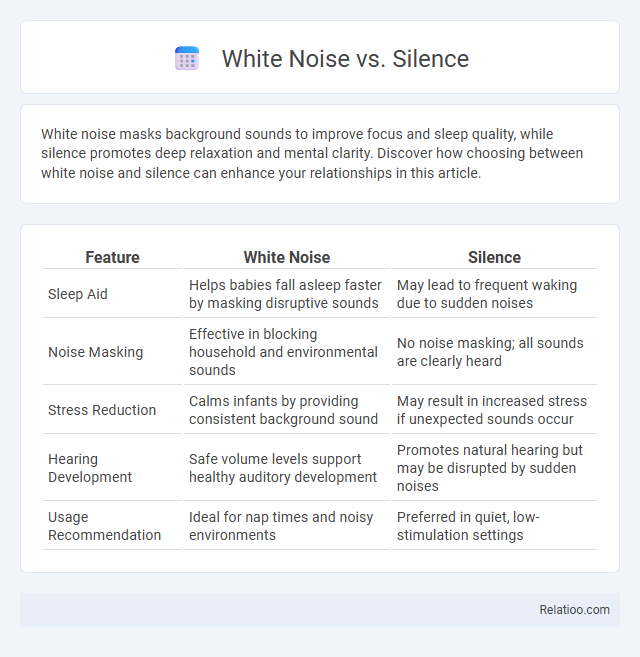White noise masks background sounds to improve focus and sleep quality, while silence promotes deep relaxation and mental clarity. Discover how choosing between white noise and silence can enhance your relationships in this article.
Table of Comparison
| Feature | White Noise | Silence |
|---|---|---|
| Sleep Aid | Helps babies fall asleep faster by masking disruptive sounds | May lead to frequent waking due to sudden noises |
| Noise Masking | Effective in blocking household and environmental sounds | No noise masking; all sounds are clearly heard |
| Stress Reduction | Calms infants by providing consistent background sound | May result in increased stress if unexpected sounds occur |
| Hearing Development | Safe volume levels support healthy auditory development | Promotes natural hearing but may be disrupted by sudden noises |
| Usage Recommendation | Ideal for nap times and noisy environments | Preferred in quiet, low-stimulation settings |
Introduction to White Noise and Silence
White noise masks disruptive sounds by providing a consistent auditory environment that helps improve your focus and sleep quality. Silence, on the other hand, eliminates external noise but may expose sudden sounds that disturb rest. Balancing white noise and silence is essential for optimal sleep hygiene, as it fosters a calming setting that supports healthy sleep patterns.
Understanding White Noise: Definition and Types
White noise consists of a consistent sound frequency that masks disruptive environmental noises, promoting better sleep quality and focus. Common types include fan sounds, static from a radio, and specialized white noise machines designed to emit soothing audio frequencies. Your choice of white noise can significantly enhance sleep hygiene by creating a stable auditory environment that reduces distractions and encourages restful sleep.
The Science Behind Silence
Silence promotes restorative brain functions by reducing sensory input, allowing deeper slow-wave sleep essential for memory consolidation and cellular repair. Research shows that exposure to absolute quiet can lower cortisol levels, enhancing relaxation and reducing stress-related sleep disturbances. Compared to white noise, which masks external disruptions, silence optimizes sleep hygiene by supporting natural circadian rhythms and neural homeostasis.
Benefits of White Noise for Sleep and Focus
White noise creates a consistent auditory environment that masks disruptive sounds, enhancing your sleep quality and improving concentration during work or study. Unlike silence, which may make sudden noises more startling and interrupt deep sleep cycles, white noise promotes uninterrupted rest by stabilizing the auditory backdrop. Incorporating white noise into your sleep hygiene routine supports relaxation, reduces stress, and boosts cognitive performance by fostering a calm, distraction-free atmosphere.
Health Benefits of Embracing Silence
Embracing silence supports mental clarity, reduces stress hormone levels, and enhances deep sleep quality, which contributes to overall health improvements. Unlike white noise, silence allows your brain to engage in restorative processes and promotes mindfulness, reducing anxiety and improving cognitive function. Prioritizing silence as part of your sleep hygiene routine can lead to better emotional regulation and a more restful, rejuvenating night's sleep.
White Noise vs Silence: Impact on Mental Health
White noise creates a consistent auditory environment that can mask disruptive sounds, promoting relaxation and reducing anxiety for improved mental health during sleep. Silence offers a completely quiet atmosphere, which may benefit individuals sensitive to noise but can sometimes highlight internal distractions or stress. Your choice between white noise and silence should align with your sleep hygiene preferences to optimize restful sleep and emotional well-being.
Productivity: White Noise or Silence for Work?
White noise can enhance your productivity by masking distracting background sounds, creating a consistent auditory environment that helps maintain focus during work. Silence, however, allows for deeper concentration and can be ideal for tasks requiring complex problem-solving or creative thinking. Prioritizing your sleep hygiene supports overall cognitive function, making it easier for you to stay productive regardless of whether you choose white noise or silence while working.
Drawbacks of Relying on White Noise
Relying on white noise for sleep can disrupt natural sleep cycles by masking important environmental sounds, potentially reducing the brain's ability to respond to real threats or signals. Long-term dependence may also hinder the development of healthy sleep hygiene practices, such as establishing a consistent bedtime routine or optimizing the sleep environment without artificial noise. White noise machines can pose risks of hearing damage at high volumes and may not address underlying sleep disorders, leading to persistent sleep problems despite their use.
Potential Downsides of Prolonged Silence
Prolonged silence during sleep may increase stress hormone levels and disrupt the natural regulation of the nervous system, potentially leading to fragmented sleep and heightened anxiety. White noise, in contrast, masks environmental disturbances and promotes consistent sleep patterns by stabilizing auditory input. Effective sleep hygiene recommends balanced auditory environments, as excessive silence might hinder relaxation for some individuals by amplifying internal noises or negative thought patterns.
Choosing Between White Noise and Silence: Which Is Best?
Choosing between white noise and silence depends on your sleep environment and personal sensitivity to sound. White noise can mask disruptive noises and create a consistent auditory backdrop, promoting deeper, uninterrupted sleep for many individuals. Your sleep hygiene improves by evaluating whether consistent sound aids relaxation or if complete silence better supports your natural sleep cycles.

Infographic: White Noise vs Silence
 relatioo.com
relatioo.com